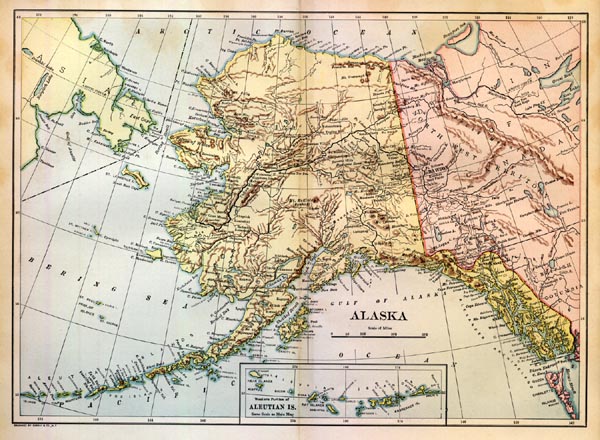

Click for weather forecast
Alaska is the largest state in the United States by area. It is situated in the northwest extremity of the North American continent, with Canada to the east, the Arctic Ocean to the north, and the Pacific Ocean to the west and south, with Russia further west across the Bering Strait. Alaska is the 4th least populous and the least densely populated of the 50 United States. Approximately half of Alaska's 722,718 residents live within the Anchorage metropolitan area.
Alaska was purchased from Russia on March 30, 1867, for $7.2 million ($120 million in today's dollars) at approximately two cents per acre ($4.74/km²). The land went through several administrative changes before becoming an organized (or incorporated) territory on May 11, 1912, and the 49th state of the U.S. on January 3, 1959.
The name "Alaska" (Аляска) was already introduced in the Russian colonial period, when it was used only for the peninsula and is derived from the Aleut alaxsxaq, meaning "the mainland" or, more literally, "the object towards which the action of the sea is directed". It is also known as Alyeska, the "great land", an Aleut word derived from the same root. The climate in Juneau and the southeast panhandle is a mid-latitude oceanic climate (Köppen climate classification Cfb) in the southern sections and a subarctic oceanic climate (Köppen Cfc) in the northern parts. On an annual basis, the panhandle is both the wettest and warmest part of Alaska with milder temperatures in the winter and high precipitation throughout the year. Juneau averages over 50 inches (1,270 mm) of precipitation a year, while other areas receive over 275 inches (6,990 mm).[14] This is also the only region in Alaska in which the average daytime high temperature is above freezing during the winter months.
The climate of Anchorage and south central Alaska is mild by Alaskan standards due to the region's proximity to the seacoast. While the area gets less rain than southeast Alaska, it gets more snow, and days tend to be clearer. On average, Anchorage receives 16 inches (406 mm) of precipitation a year, with around 75 inches (191 cm) of snow, although there are areas in the south central which receive far more snow. It is a subarctic climate (Köppen Dfc) due to its brief, cool summers. The climate of Western Alaska is determined in large part by the Bering Sea and the Gulf of Alaska. It is a subarctic oceanic climate in the southwest and a continental subarctic climate farther north. The temperature is somewhat moderate considering how far north the area is. This region has a tremendous amount of variety in precipitation. An area stretching from the northern side of the Seward Peninsula to the Kobuk River valley is technically a desert, with portions receiving less than 10 inches (254 mm) of precipitation annually. On the other extreme, some locations between Dillingham and Bethel average around 100 inches (2,540 mm) of precipitation.
The climate of the interior of Alaska is subarctic. Some of the highest and lowest temperatures in Alaska occur around the area near Fairbanks. The summers may have temperatures reaching into the 90s °F (the low to mid 30s °C), while in the winter, the temperature can fall below −60 °F (−51.1 °C). Precipitation is sparse in the Interior, often less than 10 inches (254 mm) a year, but what precipitation falls in the winter tends to stay the entire winter.
The highest and lowest recorded temperatures in Alaska are both in the Interior. The highest is 100 °F (37.8 °C) in Fort Yukon (which is just 8 miles or 13 kilometers inside the arctic circle) on June 27, 1915, making Alaska tied with Hawaii as the state with the lowest high temperature in the United States. The lowest official Alaska temperature is −80 °F (−62.2 °C) in Prospect Creek on January 23, 1971, one degree above the lowest temperature recorded in continental North America (in Snag, Yukon, Canada).
The climate in the extreme north of Alaska is Arctic (Köppen ET) with long, very cold winters and short, cool summers. Even in July, the average low temperature in Barrow is 34 °F (1.1 °C). Precipitation is light in this part of Alaska, with many places averaging less than 10 inches (254 mm) per year, mostly as snow which stays on the ground almost the entire year.
Source: http://en.wikipedia.org/wiki/Alaska

